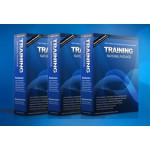Training Material Packages

Each Training Material package is supplied with a comprehensive set of documents and tools. The following section aims to familiarise you with the various documents included in each of our packages. Please feel free to download our comprehensive Product Sample Guide here which also includes all the information contained on this page.
Each Qualification material package is supplied with the following materials (unless specified otherwise):
• Learner Manual
• Facilitator Guide
• Learner Induction Guide
• Programme Strategy
• Formative Assessment Instrument
• Summative Assessment Instrument
• Assessment Guide
• Programme Alignment Matrix
• Portfolio of Evidence Guide
• Moderator Guide (Template)
1. Learner Guide
1.1 Description: The Learner Manual forms the core and basis of every Training package. Consisting of the training content and activities that are required by the learner in order to gain the knowledge, abilities and skills sets as required by the outcomes of the Unit Standard.
1.2 Design: Each Learner Manual follows a systematical design approach to effectively meet the NQF standards and Accreditation requirements. By utilizing a user-friendly design, logical flow of information and efficient use of graphic illustrations it enables the learner to easily comprehend and achieve the outcomes contained in the manual.
1.3 Features:
a) Content Index and NQF Alignment Reference
b) Learner Notes and Introduction
c) The Learning Approach and Structure
d) The Learning Objectives
e) Main Training Content and Activities
f) Self-Assessment Questions and Tasks
g) Review Questionnaire
2. Facilitator Guide
2.1 Description: The facilitator guide serves as a implementation / delivery guide of the Learner Manual for the Trainer during the facilitation of the training session. Consisting of the objectives, preparation notes, lesson planning and delivery instructions; this document forms a solid guide and reference for the Trainer during the training session.
2.2 Design: The Facilitator Guide follows a systematical design approach to enable the facilitator to successfully deliver and facilitate the Training programme.
2.3 Features:
a) Content Index
b) Alignment Reference
c) Learning Approach
d) Objectives and Outcomes
e) Lesson Planning
f) Notes and Guidance
g) Administrative Tools
3. Formative Assessment Instrument
3.1 Description: The Formative Assessment Instrument serves as a tool to formatively assess the knowledge and skills sets as required by the outcomes of the Unit Standard. Consisting of a variety of assessment techniques to effectively assess the candidate’s level of competency; this document forms the basis of the initial and on-going implementation of the outcomes-based assessment methodology.
3.2 Design: Each Formative Assessment Instrument follows a systematical design approach to effectively meet the NQF and outcomes-based assessment standards. By utilizing a user-friendly design and through an efficient use of assessment strategies, you are able to formatively assess the level of competency of the candidate based on the outcomes of the training programme.
3.3 Features:
a) Content Index and Alignment Reference
b) Introduction, Instructions and Memorandum
c) Assessment Plan and Appeals Procedures
d) Assessment Preparation Checklist
e) Formative Assessment Content
f) Classroom Activity Completion Confirmation
g) Feedback Declaration and Evaluation
4. Summative Assessment Instrument
4.1 Description: The Summative Assessment Instrument serves as a tool to summatively assess the knowledge and skills sets as required by the outcomes of the Unit Standard. Consisting of a variety of assessment techniques to effectively assess the candidate’s level of competency; this document forms the basis of the summative and on-going implementation of the outcomes-based assessment methodology.
4.2 Design: Each Summative Assessment Instrument follows a systematical design approach to effectively meet the NQF and outcomes-based assessment standards. By utilizing a user-friendly design and through an efficient use of assessment strategies, you are able to summatively assess the level of competency of the candidate based on the outcomes of the training programme.
4.3 Features:
a) Content Index and Alignment Reference
b) Introduction, Instructions and Memorandum
c) Assessment Plan and Appeals Procedures
d) Assessment Preparation Checklist
e) Summative Knowledge Assessment Content
f) Summative Practical Assessment Content
g) Workplace Assignments
h) Personal Narrative
i) Witness Testimonials
j) Logbook
g) Feedback, Declaration, Evaluation and Review
5. Assessment Guide
5.1 Description: The Assessment Guide serves as a tool for the Assessor to effectively achieve the objectives of the Formative and Summative assessments included in the Training Programme. Consisting of effective guidance towards the assessment approach, methodology and strategy that should be followed to meet the assessment outcomes; this document forms the basis of the guidance required to effectively implement the outcomes-based assessments.
5.2 Design: Each Assessment Guide follows a systematical design approach to effectively meet the NQF and outcomes-based assessment standards. By utilizing a user-friendly design and through the provision of sufficient guidance and instructions you are able to complete the assessments to effectively determine the level of competency of the candidate based on the outcomes of the training programme.
5.3 Features:
a) Content Index and Alignment Reference
b) Assessment Plan and Appeals Procedures
c) Assessment Preparation Checklist
d) Assessment Strategy and Process
e) Evidence Grid and Memorandum
f) Formative Assessment Guidance
g) Summative Knowledge Assessment Guidance
h) Summative Practical Assessment Guidance
i) Workplace Assignment Guidance
j) Personal Narrative and Witness Testimonials
k) Logbook
l) Feedback, Declaration, Evaluation and Review
6. Moderator Guide (Template)
6.1 Description: The Moderator Guide Template serves as a tool for the Moderator to customize in order to effectively moderate the Assessments conducted by the Assessor in the Training Programme. Consisting of effective templates and guidance towards the moderation approach, methodology and strategy followed to meet the outcomes; this document forms the basis of the guidance required to effectively moderate the assessments conducted.
6.2 Design: Each Moderator Guide follows a systematical design approach to effectively meet the NQF Accreditation Body’s requirements. By utilizing a user-friendly design and through the provision of sufficient guidance and instructions you are able to complete the moderation of assessments based on the outcomes of the training programme.
6.3 Features:
a) Content Index and Alignment Reference
b) Moderator’s Instructions
c) Instructions and Memorandum
d) Assessment Strategy
e) Assessment Process
f) Moderation Report
g) Moderation Recording Tool
h) Feedback and Judgement Record
7. Programme Alignment Matrix
7.1 Description: The Alignment Matrix serves as a NQF alignment reference that demonstrates the alignment of the Training programme’s outcomes to that of the Unit Standard. Consisting of learning outcomes, assessment strategies and alignment references; this document forms a basis of demonstrating the NQF alignment of the Training Programme.
7.2 Design: The Alignment Matrix follows a systematical design approach to effectively meet the NQF Accreditation Body’s requirements. By utilizing a user-friendly design and through the provision of sufficient alignment information, you are able to demonstrate compliance and alignment towards the Unit Standard being addressed by the Training programme.
7.3 Features:
a) Clustering Information
b) Notional Hour Breakdown
c) Programme Objectives
d) Unit Standard Information
e) Learning Outcomes
f) Learning Material Alignment
g) Resource requirements and delivery methods
h) Assessment Strategy and Reference
8. Learner Induction Guide
8.1 Description: The learner induction guide serves as an induction tool used to effectively introduce the candidate to the NQF learning approach, design and methods widely used in the Training programmes. Consisting of sufficient instructions, explanations and guidance; this document forms a basis of knowledge and understanding that the candidate requires to complete NQF aligned Training and Assessment processes.
8.2 Design: The Learner induction guide follows a systematical design approach to effectively meet the candidate’s needs and NQF Accreditation Body’s requirements. By utilizing a user-friendly design and through the provision of sufficient guidance and instructions, the learner is able to effective understand and complete the processes involved to achieve the Training outcomes.
8.3 Features:
a) Learner Workplace Orientation
b) Introduction to the National Qualifications Framework
c) Rights & Responsibilities and Agreement of parties
d) Appeals Procedures & Appeals Form
e) Workplace Evaluation and Shift Roster
f) Practical Learning Hints
g) Disciplinary Procedures
h) Certification and Assessment
i) Principles of Assessment
j) Moderation, Assessment and Feedback
k) Breakdown of Qualification
l) Learner Declaration of understanding
9. Programme Strategy
9.1 Description: The Curriculum Guide (Programme Strategy) serves as a NQF alignment reference that demonstrates the alignment of the Training programme’s outcomes to that of the Qualifications. Consisting of learning outcomes, assessment strategies and alignment references; this document forms a basis of demonstrating the NQF alignment of the Training Programme.
9.2 Design: The Curriculum Guide follows a systematical design approach to effectively meet the NQF Accreditation Body’s requirements. By utilizing a user-friendly design and through the provision of sufficient alignment information, you are able to demonstrate compliance and alignment towards the Qualification being addressed by the Training programme.
9.3 Features:
a) Key Elements and Outline
b) Alignment Strategy
c) Programme Objectives
d) Assessment Strategy and Reference
e) Delivery Strategy
f) Learning Outcomes
g) Learning Material Alignment
h) Resource requirements and delivery methods
10. Portfolio of Evidence Guide
10.1 Description: The Portfolio of Evidence Guide serves as a instructional tool and guide that explains the Assessment types, methods and requirements used for compiling the Portfolio of Evidence. Consisting of clear guidance and explanations, this guide aims to familiarise the learner with the process to follow to build their Portfolio of Evidence.
10.2 Design: The Portfolio of Evidence Guide follows a systematical design approach to effectively meet the NQF Accreditation Body’s requirements. By utilizing a user-friendly design and through the provision of sufficient instructional information, you are able to guide the learner into the correct process for collecting and compiling the evidence needed for their Portfolio of Evidence.
10.3 Features:
a) Introduction
b) Assessment Types, Methods and Requirements
c) Portfolio Building Process
d) Assessment Process and Procedure
e) Assistance and Support
Our comprehensive Training Material Packages are stuctured and aligned to the requirements for SETA Accreditation and Approval.



